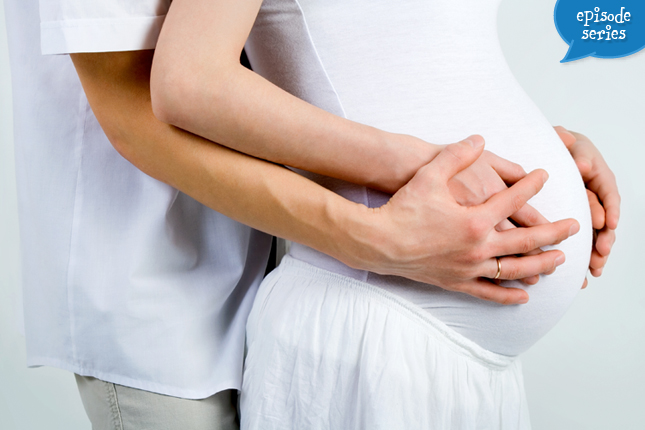Preggie Pals
Childbirth Choices: Waterbirth
Please be advised, this transcription was performed from a company independent of New Mommy Media, LLC. As such, translation was required which may alter the accuracy of the transcription
[Theme Music]
ANNIE LAIRD: More pregnant women today are exploring giving birth in the water as a childbirth choice. How widespread is this practiced? What are the benefits and are there any risks associated with Waterbirth? Where can women in the United States currently chooses as an option? Joining us today is Barbara Harper, the founder of Waterbirth International and author of Gentle Birth Choices, and today we are exploring Waterbirth as an option for your birth. This is Preggie Pals, episode 78.
[Theme Music/Intro]
ANNIE LAIRD: Welcome to Preggie Pals broadcasting from the Birth Education Center of San Diego. Preggie Pals is your weekly online, on-the-go support group for expecting parents and those hoping to become pregnant. I’m your host Annie Laird. Thanks to all of our loyal listeners who have joined the Preggie Pals Club. Our members get special episodes bonus contents after each new show plus special giveaways and discounts. You’ll also get a free subscription to pregnancy magazine. See our website for more information. Another way for you to stay connected is by downloading our free Preggie Pals App available in the Android and iTunes marketplace. Would you like to participate in our discussions as a panelist but you don’t live in San Diego? Or is it too difficult to get in the studio on our recording day? Become a virtual panelist. Share your tips for new parents and join our conversations from anywhere in the world. See our website www.preggiepals.com for more details.
Welcome to everybody joining us today, let’s go around the studio and introduce all the panelists. Let’s start off with Stephanie, our producer who’s in here today.
STEPHANIE SAALFED: Hi! I’m Stephanie, I am 30. I have a 9 month old little girl at home and I’m very interested to hear about waterbirth today
CHRISTINE HARPER: Hi! My name is Chris Harper. I’m 35. I’m a birth doula. I have 4 kids. The first was a planned hospital, a planned home birth, home waterbirth and then turned into hospital induction. The second and third were hospital birth center births, one was in the water and my last was a home waterbirth, it was a midwife.
MELISSA LANG LYTLE: Hi! I’m Melissa Lang Lytle. I am a birth doula and also consider myself a birth activist. I am 42 years old. I have 2 children, an almost 5 year old and a 3 year old. I’m actually due with my third baby, January, at the end of January. A boy!
ANNIE LAIRD: Great! My name’s Annie and I’m the host and I’m 35. I’m a government contractor by day and when I’m not pregnant I’m a birth doula. I’m pregnant with my third baby and he/she, we’re not sure of the gender is due on the 24th so I’m thinking maybe a little bit earlier, but we’ll see here in a couple of weeks. This is my third child and I’m planning a homebirth
[Theme Music]
SUNNY GAULT: We have a comment from one of our listeners and this comes from Carrie. Carrie writes:
“Hi Preggie Pals! I just joined the Preggie Pals Club, and I have to say my favorite part is the extra bonus content after each new show. I usually listen to the app but I’m wondering if there’s a way to listen online as well”
So, Carrie, yes there is. All you have to do is head on over to www.preggiepals.com , our website. Click on the member’s section, you’ll see a log in section there. Log in to your account using the same login information that you used on your app and you’ll be able to download the content right there or you can listen to it online. It just allows you into our members area and you can do a whole bunch of cool stuff. Get access to all of our extra features. So, Carrie thank you so much for your question.
[Theme Music]
ANNIE LAIRD: Today on Preggie Pals, we’re discussing waterbirth as a childbirth choice. Our expert for today is Barbara Harper. Barbara is an internationally recognized expert in waterbirth. A published author and a childbirth reformed activist. She founded Waterbirth International in 1998 with the goal of making waterbirth an available option for all women. During the past four decades, Barbara has worked as a pediatric nurse, a childbirth educator, a homebirth midwife, a midwifery instructor and a doula so she’s a very busy lady. She is the author of the best-selling book Gentle Birth Choices and has also produced the film Birth into Being: The Russian Waterbirth Experience. Her next book, Waterbirth: A Contemporary Guide for parents and providers will be ready for publication in 2014. Barbara has dedicated her life to changing the way we welcome babies into the world. Barbara, welcome to the show and thanks for joining us today
BARBARA HARPER: I’m really happy to be here and hello panelists, and I’m so happy to hear that some of you have had home waterbirth and birth center waterbirths such amazing
ANNIE LAIRD: Barbara let’s start off with, why should women consider waterbirth as an option during childbirth? What are some of the benefits that they should know about?
BARBARA HARPER: I was just teaching that to my midwifery students the slide that was up are what does the research shows that are the benefits of water. And I think water is the great normalizer for pregnancy and birth. In the UK there’s an organization called the National Institute for Health and Clinical Excellence and in 2007, they brought together the obstetricians, the midwives, the childbirth educators, the people who were involved in creating National Health Policy, and they also had in the room and say what, what would make birth more normal? And the very first thing that they all agreed upon was immersion in water. And there’s physiologic effects that happen by being in a warm fostering you know birth process and there’s also an emotional component and there’s also a pain relieving component. So, all these things are working together. And the bath depending on the size of the vessel that holds the water really relieves the woman from being in one position. It liberates her so she’s able to move and follow the cues that the baby is giving her. And it just really totally makes her more comfortable. Imagine doing the hardest work you’ll do in your whole life while soaking in a hot tub. I mean what could be bad about that?
ANNIE LAIRD: That sounds pretty awesome. We’ll go around with our panelists of the ladies who’ve had have waterbirths, with what Barbara is saying as far as pain relief, what was the advantage that you found during your waterbirth that you liked about that experience?
MELISSA LANG LYTLE: Well it was an incredible pain reliever just as I was moving through my contractions to step into a comfortable warm bath. Just felt soothing and comfortable. I also like how lightweight I felt because being pregnant and in active labor, gravities doing its job so to be kind of lightweight and feel more free to move around as Barabara said just felt really comfortable and again the pain relief just allowed me to kind of open up and really concentrate on what the baby was telling me in terms of where I needed to move my body
BARBARA HARPER: What she says is so true because There’s a physiologic effect that a large, a deep tub will have for you and that is to give your body more oxytocin in your pain. Actually delivers more oxytocin by being in the water. And if you have more oxytocin, your labor goes faster and that’s what this pains reveal and it means that you have more pain relieving endorphin, you, not pain relieving, pleasure enhancing, I don’t like to even mention the word pain in labor
ANNIE LAIRD: It’s the “P” word, yes
BARBARA HARPER: Yeah, it turns pain to pleasure and also the component that you feel safe in the water. It’s your space; it’s now kind of your own little womb that you’re now soaking in
CHRISTINE HARPER: That, that was a big thing for me, I felt, I felt safe in the water. I felt that I was in my own space and that I could move freely I was weightless and I also felt more modest in the water. I felt like I was unexposed
ANNIE LAIRD: As opposed to have lying on the bed with your legs wide open and the janitor comes in, exactly, everybody come on in, take a look. Barbara, what temperature should the water be? Is there, I imagine if it’s too cool then the mother would get chilled, but if it’s too hot, you know, I guess, I hear a lot through my own pregnancy with my own care you know “don’t get on a hot tub basically that you’ll overheat the baby” so, what kind of temperature should the water be?
BARBARA HARPER: Whatever’s comfortable for the mother and I don’t like to put numbers on it per se and yes you can take the temperature of the water with the little floaty ducky thermometer, dolphin thermometer but, they’re not exactly accurate, they’re plus or minus two degrees in accuracy. So what I like to gage it on is just a high temperature not above 101. Your skin temperature as opposed to your oral temperature, your skin temperature is between 92 and 95, so even at 97 degree bath or a 98 degree bath or a 100 degree bath, is going to feel very warm and very comfortable.
We don’t want to have it too high of temperature like you mentioned, you might get overheated and you see we can, we can sweat and deal with you know outside temperatures of a 100 degrees, even San Diego have a very nice because it’s idea of temperature all year round. Here in Miami, Florida, you know, we get 95 and a 100 percent humidity and we sweat. A woman in a bath tub, it loses that ability so she gets overheated, the baby gets overheated. The baby’s heart rate will go up and it’s not a permanent thing that it’s going to cause problems for the baby, but if it goes on for a very long time, the baby gets tired and then the heart rate drops.
So, we want to have her in the water as long as she’s comfortable at a temperature that she’s comfortable. So, and women, I keep women to the wide and swim, or in their private birth or their private pools here in Florida we get in the ocean and swim during labor, you know it’s not a problem, absolutely.
ANNIE LAIRD: Okay. Now, when during the labor should the mother into the water, I know that with my second birth it was, it seemed to be that when I was still very very comfortable in labor. My midwife’s weren’t even feeling a bit up with that point. Are there issues with getting into early?
BARBARA HARPER: Not in my practice, if you called me up in the middle of the night and said that my contractions were consistently increasing in frequency and in lengths, they were getting longer and stronger. And you wanted some sort of relief I would say go get into the bath tub. I have had people get into the bath tub early in labor and three hours later having a baby. So, there was something written that you shouldn’t get into a warm bath until you’re, basically 5 or 6 centimeters dilated. But I would like to take that off the table and not even think about it.
Use the bath not to get in and stay there for the rest of your labor but use the bath in the first ninety minutes of being in immersion. You do have a change in your posterior pituitary and it does pump out more oxytocin. And at the same time you have this relaxation effect that’s going to cut down the amount of in your brain and then so you will relax, but your contraction pattern is going to be more efficient in the tub. And what we saw was these women we’re just so relaxed they weren’t responding the same way those women responds on the bed.
But if you put them on monitor, water proof monitor, on that woman in the bath tub, it’s going to have the very same contraction pattern if not better in the tub. It’s just that she’s not responding to it in the same way, so what appears that she has a slower contraction pattern and more frequent contractions but that’s not what is happening. So, the average time that a woman spends in the tub, from the moment she enters to the moment that she has her baby.
And she can be in and out, she can be in for half an hour, get out, go to the toilet or the porcelain self cleansing birthing stools, I like to call it. Or she can walk around or she can go outside and take a walk when she’s at home. I’ve even had women in the hospital I’ll take them for a walk in the hall we’ll go outside take a walk, come back in, and then get in the bath again. So, it’s not a place where you have to stay for the whole entire labor but the average length of time of study when we’re comparing women giving birth in water and women giving birth on the bed, I call that surf and turf.
And it’s about 229 minutes as opposed on the bed for about 339 minutes so, at least an hour or more. The bath cuts down the amount of time of labor no matter when you get in even if you’re 2 centimeters dilated. Wouldn’t you rather do that than beg for an epidural?
ANNIE LAIRD: Well not like that one is available in my living room anyways, no epidurals in the living room
BARBARA HARPER: Right, exactly. Well waterbirth is now available in over 300 US hospitals, that’s 10 percent of all US hospitals.
ANNIE LAIRD: That’s great. And you know and it’s interesting you mention of just like some women maybe would get undermined with the waterbirth like you said the you know you get in the water and you stay in the water but that might not be the case. For my last birth I was in the water and then just had a point I felt like I needed to get out have I not transferred to the hospital shortly after then I probably would have had the baby on the bed. But just that pain relief as the panelists we’re saying that really helped out and helped me progress while I was in the water. And then, when I felt like it did need to be in there that was fine I could get out
BARBARA HARPER: We have to think, we have to, when I’m teaching the students here, we, I have to instill upon them is it’s not your job to get the baby out, it’s your job to setup the environment, to support the mother so that she can listen to her baby and the mother is the vehicle and the baby is the driver. It’s the baby‘s birth experience. And the mother is allowing the baby to emerge, and the more we can switch that around and look at what can we do to make the woman as comfortable as possible, safe as possible as relaxed as possible and the bath is one way but also our words and our actions and holding that space for her.
So, when women graduates from my doula course, I call them environmentalist instead of doulas because they set up the environment, both mentally, physically and spiritually for this birth to take place
ANNIE LAIRD: Barbara, you mention a little bit earlier talking about waterproof monitors. Now with a waterbirth how would the midwife or the doctor or the nurse, how would they monitor that baby and make sure that the baby’s doing well?
BARBARA HARPER: When and, by the way I didn’t mention that I’ve given birth twice in water as well. Once in the hospital, and I don’t even want to describe that birth we don’t have all day. But that was my daughter who’s turning 35 next month and my two boys are 29 and 27 and they were both born at home. And in those days we didn’t have waterproof dopplers, so, if we wanted to listen to the baby we had to stand up out of the water. And my first waterbirth, the midwife who checked me, I got into the tub, she was late getting to my house.
I labored all day I got into the tub that I built myself, this is 1984 and she checked me, I got in, and then she wanted to listen to the heart tones and so she said “please stand up” so that she could put her stethoscope on my belly and listen to the heart tones. And the difference between contraction in the water and when I stood up it was so powerful, and so strong, that I looked at her and I said “forget the baby, I don’t want to be out of the water” and I sat back down. And you know if you want to listen to him, you’re going to have to come in the tub with me. And I was not going out of that tub, not again
ANNIE LAIRD: One more contraction after that point
BARBARA HARPER: Yeah and he was born 15 minutes later. So, and when I got in I was 7 centimeters dilated and he was born 15 minutes later. And sometimes it’s like a powerful free train or a lightning bolt that hits your body when the baby gets expresses their primitive reflexes to go through the pelvis and be born, that’s their job. Their brain is wired to do it in a sequence and that is logical and follows a pattern and unfortunately we interfere with that pattern a lot. But today, we have waterproof dopplers, I was responsible for bringing the first waterproof Doppler to the US and introducing that.
And now we also have waterproof monitors to mimic the monitors in the hospital so that doctors, even though the monitor has been proven as only contributing to an increase in cesarean section rates and not necessarily contributing to the safety of birth in babies. But if you listen, and according to ACOG’s Standards, every half hour in first stage and every five minutes or after every expulsive effort in second stage you’re going to project whether or not the baby is tolerating the labor. So it’s easy to do.
And in Norway, they have these things called Pinards which is kind of like a little bell, a stethoscope that you listen to the baby and they still use those and they made a six foot long one so that they could put it in the water and it’s made out of tin and so they don’t have to use anything electronic and it’s all natural. So, a six foot long stethoscope to put into the water.
ANNIE LAIRD: Wow, you will need a long type of box for your midwife to put that in there, so bring them in separately I suppose.
BARBARA HARPER: Yes.
ANNIE LAIRD: When we comeback we will be discussing physiologically what’s going on with the baby during the birth. We’ll be right back.
[Theme Music]
ANNIE LAIRD: Welcome back, today we’re talking about water birth as an option during your birth with Barbara Harper. Barbara could you go into a little bit about what physiologically is going on with the baby? I know that there’s seems to be some concern maybe with hospital birth or trying to bring that into the hospital, you know, I think the biggest question that people unfamiliar with waterbirth have is well prevents the baby from breathing underwater. Could you go into little bit what happens physiologically with the baby during the process of birth in a waterbirth?
BARBARA HARPER: That’s the, used to be the number one question that people would ask me when they’d email me or call me up on the phone, “we’ll won’t the baby take a breath?” or they even use the “D” word “what if the baby drown?” And I say, “every baby grows in fluid and when it comes out in fluid it’s still attached to the umbilical cord and it’s getting it’s oxygen from the placenta. About 48 hours before a normal labor begins the baby signals from the brain that it’s long mature it’s ready to be born its 41 weeks and three days, that’s the average for a first time birth. You know and by the way due date are should be called gestates and babies are born on their birth dates not their due dates. But anyway, the baby signals all that and part of the signal on ready to transition from womb to room.
ANNIE LAIRD: I like that, I’m going to start using that “womb to room” that’s awesome
BARBARA HARPER: Yeah and it transitions to take place to grow a fetus is the womb the place to grow a newborn is your chest. And birth is the transition from fetus to newborn. And so the fetus has to get ready to make that transition. It’s the most critical period of human existence is that transition and the more normal we keep the labor the easier it is, easier it is for the baby to transition and the baby definitely take a breather inside the womb.
Its circulation bypasses the heart, it bypasses the kidney, it bypasses the liver, it bypasses the skin. And all of that is handled by the placenta, this wonderful oxygen tank that is attached to the baby by the umbilical cord. So all of that is working in the womb and as the baby comes out, it’s breathing mechanism hasn’t come online yet. It’s like, I tell moms all the time some babies are pissies and some babies are max. When the baby comes up out of the water some babies go “waaaaahhh!!!” right away and other babies take their transition.
Those babies that cry right away when they come up out of the water are doing the same thing that the baby on the bed does. But the baby on the bed, its head hangs on the perineum for 2 to 3 minutes before its shoulders are born. The baby that comes out of the water has just gone from inside the womb to a now an expanded womb that has, it’s a womb with a view. The baby’s going to act the same way that it did in the womb that it will in the water.
So it winks its eyes, it moves its muscles and it starts coming online and very gently brought up to the surface. And its face, it makes contact with the atmosphere, the atmosphere of pressure, the gravity and the presence of oxygen and carbon dioxide molecules and that changes the brain chemistry. And this whole time that the placenta is working, we don’t cut the cord, we don’t clamp the cord, there’s no physiologic reason to do that this is a there’s every reason not to clamp the cord.
We got it wrong and now finally, science is catching up and you don’t want to clamp or cut the cord until after the placenta has sheared off the wall of the uterus and basically has been born. The baby and the placenta are one unit and the baby gets 40 percent of its postpartum blood supply from that placenta. We do that in waterbirth and that’s how I teach waterbirth to doctors and medical schools and they go “really? That’s what happens? Oh My Gosh that makes so much sense” because the baby needs that oxygenated blood from the placenta in order to make that transition easier for the baby.
So, the baby cannot physiologically attempt to breathe, it can swallow water but it’s only in the tub for 3 to 5 seconds. And you might see a cord around the neck while only after it’s born and you just simply lift that off and then gently lift your baby up to the chest where it just stays for the next 15 or 16 years
ANNIE LAIRD: I don’t know I’m about 9 months pregnant and when my eight year old tells me to pick her up, I go “that’s nice, here, sit down next to mom in the couch and come in for a hug”
BARBARA HARPER: Well you can still cuddling that though. And it has to be make it skin to make it skin. And people ask me all the time, are water babies special? And yes they are because their mothers had education, their mothers have no drugs their mothers we’re conscious and had their full compliments of the hormones of labor which are oxytocin the hormone of love, endorphins, the hormone of pleasure and transcendence, adrenaline or norfenefrine the hormone of excitement and then prolactin as soon as that that placenta shears off the wall in the uterus, your prolactin pumps out into your brain and the presence of the baby on your chest changes your brain chemistry as well as wires your baby’s brain chemistry to say that I’m alive, I’m in the right place, my body is functioning.
I made the right decision, I am loved, I am perfect, I am whole, I am unique, I am wonderful. And the baby’s cord gets cut right away and gets put over in the warmer and on the table and is examined and poked and prodded and says “what did I do wrong? I must be in the wrong place”. Because the only place to transition a baby is on your chest and that’s why water babies are so awake, aware and alert. Because they come on to that chest and stay there and yes we have emergencies with babies that maybe won’t take a breath right away but the worst possible thing to do is cut their cords. We have to transition them on the mother’s chest even in an emergency situation. And we will see this change within the next 5 to 10 years as the science catches up with medical schools, we’ll see that change. We absolutely will see that change. I promise you.
ANNIE LAIRD: We’ll I like to ask our panelists because, I’m so happy that both of you are here because you have had the land of birthing experience. What the proper to call that, that was the turf right so yeah you’re turf birth and then you had your surf birth and you had one after the other with your children. Did you notice any difference with your children in their newborn behavior? Or even now in their personality?
MELISSA LANG LYTLE: You know, I think the children come out with their personalities and it’s very different. I will say the birth transition by being in the water was just so smooth and so easy for him that I felt like it just made sense. So, everything felt really easy and felt really natural for me, it just everything made sense, I don’t know I keep saying that but that’s how it felt at that time
CHRISTINE HARPER: For me I had to out of the water and in to the water and I would say the bonding was different with the last three that we’re born naturally without induction or epidural. The bonding at that immediate time was definitely different. Their personalities, I don’t know, how much they do with the water, I will say the last two, and they were a little noisier. And I don’t know if it had anything to do, they just make little grumbles and grunts and they were happy babies, they were content and calm and especially my last one. That was born at home in the water, very mellow. But, I don’t know, I don’t know if it was difference with the water our out but, yeah, they’re all very different
MELISSA LANG LYTLE: I know the birth experience itself was smoother and gentler and for that I’m grateful versus the little bit louder all the bright lights transitioning from water to air. So, I like being able to give that to my babies transition.
ANNIE LAIRD: Definitely.
MELISSA LANG LYTLE: So, I had a land birth, I had a turf birth and now I had a surf birth. So my question going into my third birth is, I felt like that primal amniotic fluid’s smell. I couldn’t stop smelling my baby from my first birth and so, now right now I’m having this question of the waterbirth was such an amazing transition that I thought was easier for the baby and more comfortable for me. But I didn’t smell the amniotic fluid as strong, could that be because of the water? Or could that because he just had less amniotic fluid on him in the womb?
BARBARA HARPER: The fact that they come through the water, the research has shown that the bacteria like if you’re GBS positive, the bacteria’s going to be diluted in the water. So there are some things that are diluted. Now and I would say the solution to delusion is dilution. But you know if you have negative bacteria like herpes or HIV positive or AIDS mothers, absolutely I would only deliver them in the water.
I would only suggest that they birth in the water because it kills the virus on contact. So it now becomes not an issue but the signals that, and yes, there’s nothing like be born smell. It was mostly, and when you smell that, your oxytocin levels actually go up. So that’s why I never put a hat on the baby, never ever put a hat on a baby because the baby’s hair has all that amniotic fluid smell in it, and that stays the longest.
So take that, you know, I you have the opportunity to work with mothers, just tell them, the baby doesn’t need a hat. Until it goes out into cold weather and in San Diego you certainly don’t need a hat. We are the only ones who actually put that on baby. But, I was asked by, Marshall Clause, well, how can the baby find the breast? It’s the amniotic fluid that’s on it that’s the hands and that’s part of finding the nipple. In actuality it’s your pheromone that could release and the baby picks it up from a second olfactory nerve, it’s a branch of the olfactory nerve.
And so, and those pheromones are released from around your nipple, the areola, from underneath your armpit, from your lymphatic glands and the baby is going to find that nipple no matter what even if you are unconscious, the baby would latch on. And so it doesn’t, that part cannot wash off and so the baby’s going to have that instinct to travel north and attach self attach to a breast. So, yes you might lose some of the smell, might wash off a little bit but everything else soaks in and that’s why we don’t wash babies at all. I don’t wash them, except their bums for at least the first 3 or 4 days after a birth because everything needs to soak in that smell and that vernix that’s all part of the baby’s immune system and we just take that away.
ANNIE LAIRD: Well, thank you Barbara for joining us today.
BARBARA HARPER: My pleasure.
ANNIE LAIRD: For more information about Barbara and her work with waterbirth as well as information about any of our panelists visit the episode page on our website. This conversation continues for members of our Preggie Pals Club. After the show, Barbara will share her experiences with working with hospitals to introduce waterbirth as an available childbirth choice and those settings. To join our club, visit our website www.preggiepals.com .
[Theme Music]
KRYSTAL STUBBENDECK: Hello Preggie Pals, I’m Krystal Stubbendeck , maternity fashionist and founder of Borrow For Your Bump, where you can buy or rent maternity style for a monthly rate. Today we are going to talk about the upcoming Fall Fashion trend for moms to be. These little ideas and wardrobe essentials are stylish and versatile as your bump grows and can easily transform your look as a new season approaches. Trend number one is the long sleeves mini.
The key to this statement dress is to show skin in some areas while keeping others covered up. We love long sleeve styles that show off more life. The trick is to keep the fit loose and flowing. Added belt or tie over the bump which will create curve. For fall we love the colors of condiments. Think all greens and mustard yellow. To tie this most together, avoid the skinny heel and try comfy wedges. Trend two is sexy stripes. Whether you are more on the hippie side or if you want to create curve, stripe is one detail that works for many body types. Think of thinner stripe and dark colors. Wider stripe can make your bump and back side appear larger.
Focus on a fit that hugs your curves and has blue stripe. This type of dress looks good on many body types whether you want to create curves or even balance wide hips. Tie the look together with some flat knee high boots. For our third trend, prints are all the heights as well. Have fun with different styles but make sure that the colors match. We love a silky print dress for a more dressed up look with purple and aqua tone. Dress prints down by taking a fun print blouse and pair it with skinny jeans.
For colors we’d love orange and maybe in cream of a tan too. You’re probably seeing this next trend everywhere, leather. We love this looks for moms to be. Wear a comfy pair of stretch leather leggings with a basic gray sweater or for a retro look try a navy polka dot blouse and sun rusty colored heel. Add a fun hair piece like a bird cage for a sleek style. Our final trend for fall is dressed up detail. An incredible cocktail dress that can be worn from fall into winter is a must have. Spice up a standard little black dress and find a style with beaded detail on empire lace. An LED with a little bit of lace is often used and liked. Many of these fall trends can be found at www.borrowforyourbump.com. Enter a promo code Preggie Pals at check out and save 20% on your entire order. Thanks for listening to today’s fall fashion trends and be sure to listen to Preggie Pals for more great pregnancy tips.
[Theme Music/Intro]
SUNNY GAULT: That wraps up our show for today, we appreciate you listening to Preggie Pals, don’t forget to check out our sister shows Parent Savers, for parents with newborns, infants and toddlers and our show The Boob Group for moms who breastfeed their babies. Next week we’re talking about toxins and exposure while pregnant. This is Preggie Pals, your pregnancy, your way
[Disclaimer]
This has been a New Mommy Media production. Information and material contained in this episode are presented for educational purposes only. Statements and opinions expressed in this episode are not necessarily those of New Mommy Media and should not be considered facts. Though information in which areas are related to be accurate, it is not intended to replace or substitute for professional, Medical or advisor care and should not be used for diagnosing or treating health care problem or disease or prescribing any medications. If you have questions or concerns regarding your physical or mental health or the health of your baby, please seek assistance from a qualified health care provider.
[00:36:57]
[End of Audio]












